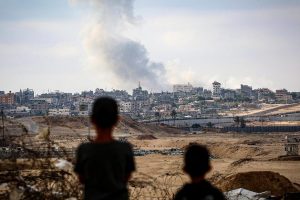
After several days of increased activity on the front lines, there don’t seem to be any new liberations to announce, but Ukraine continues to advance. Ukraine is still fairly tight-lipped about its activities, but Russian war bloggers are in full freak-out mode.
Murz is an officer in the Russian army and a popular Telegram war blogger with over 100,000 followers. Today, he wrote about Russia’s predicament on the front lines. (Post translated by Telegram’s “translate” function, with me cleaning stuff up here and there.)
In the meantime, our amazing propaganda moved from stories about the “Ukrainian counteroffensive being repelled” to stories about “Well, they finally crawled along the forefield to the first line of our defense, and what?”
Let me try again to explain what is happening in human language. It is not so important how deep the enemy has advanced, but how much the balance of forces in the direction has changed during his advance.
Fortifications, no matter how powerful they may be, including minefields, without the necessary filling of fortifications and fire cover for minefields, are of little worth. [A landmine] will not jump out of the ground and run after the “Leopard” shouting “Stop, you nasty bitch! I shouldn’t have lain in the mud for half a year!” The enemy piece of iron must itself run into these mines in an attempt to overcome the minefield or bypass it, because … because the minefield has eyes, the eyes have a radio station, and at the other end of the radio channel, for example, is a battery of 152-mm artillery. And clearing a minefield covered by fire, by any means, is a long and dreary task, which will be crowned with significant success only at the moment when the artillery battery with its guns are driven by away by immediate counter-battery, so that the mine-clearing vehicle and the platoon of sappers will be able to come up and work without being stuffed with cast iron.
Instead of artillery, there may be mobile “tourists” (anti-tank guided missiles), there may be helicopter pilots, also with ATGMs, both variations and combinations are possible.
So. If you spend all your reserves and resources on the defense of the “foreground”, and do it reasonably, because in the foreground you have places that are convenient to defend, exchanging people and equipment at the most favorable rate, then the enemy’s access to the main line of defense is very very bad. Not because you miscalculated the defense of the forefield, but because the enemy crushes you with numerical and qualitative superiority.
I will pause here to note that I still don’t understand this Russian obsession with defending in front of their defensive lines. Trenches exist precisely because they’re so hard to penetrate. Why would you defend out in the open, in front of those meticulously laid out lines, when your defenders can hunker down, better-defended against incoming fire? That’s why Ukraine has held the lines around Donetsk city since 2014: because their defenders stay in the trenches and make it impossible for Russia to advance.
Yet here is Murz talking about the areas in front of the defensive lines as “places that are convenient to defend.”
IThis officer’s account makes clear that the notion of defending out in the open is official Russian doctrine, and its officers are convinced of its wisdom. Moving on.
As I have already said, in order to break through our defenses, the enemy is not interested in the depth of his penetration into our defenses in itself, but in changing the balance of forces in the sector. If ours “grind down” faster than the enemy, then instead of an unshakable wall of the “main line of defense”, he may encounter emptiness or almost emptiness.
It is precisely in order to sharply change the balance on that sector of the front where the main prize of the summer campaign that they want lies that the enemy is carrying out attacks in other directions, including, first of all, on the flanks of Artyomovsk [Russia’s name for Bakhmut]. And his numerous “eyes” on our side of the front tell him what and where he is going there, to strengthen these flanks.
This is the argument many (like me) have been making, which really comes down to, “Ukraine is shaping the battlefield.” The failure of Ukraine’s original thrust aside, what happened next must’ve shocked Ukraine’s general staff: Rather than hunker down in their shiny new trenches, Russia sent wave after wave of soldiers to attempt to retake what little ground Ukraine had liberated. So why push forward, against heavily manned defenses, when Ukrainian troops could simply sit back and eliminate those Russian attackers out in the open field?
So as Murz notes, Ukraine became uninterested in mindlessly pushing forward, took advantage of the bizarre Russian tactics, and shifted to a “thin the herd” approach. Why not? Sitting back and killing Russians out in the open worked well. Why get in the way of their enemy’s stupidity? That delay in forward advances inevitably led to cries of, “Oh noes, Ukraine is stalled” and other such nonsense, but in reality it meant that Russia’s ability to man those lines was degraded after each one of those unfathomably stupid counterattacks to regain insignificant slices of territory.
But that wasn’t Russia’s only potential strategic miscalculation. Back to Murz:
It was in order for the enemy to pull his own reinforcements north that an offensive was launched on the northern flank of the LPR. If the enemy forces are underestimated, then this will be a waste of the critically important last-last combat-ready units that could support the flanks of Artyomovsk [Bakhmut].
The answer to the question “How did it happen that the enemy has such a numerical superiority over us, and in some places also a qualitative one?” lies in the winter and spring “meat assaults”, which gobbled up the lion’s share of the people mobilized in the fall. The enemy, constantly combing the rear for men fit for mobilization, is successfully replenished, training some, while others are being caught, and still others are already dying, paving the way for the APU forward
The “northern flank of the LPR” refers to Russia’s offensive toward Kupyansk, near the Luhansk-Kharkiv border in northeastern Ukraine. Reports place up to 100,000 Russian troops in that direction, though I find that wholly implausible. We’re certainly not seeing any assaults in force, and Russian gains have been modest at best—a few kilometers of open ground as Ukrainian troops retreat behind more defensible ground behind a river.
The point of that assault is clearly an attempt to draw Ukraine’s reserves away from Zaporizhzhia down in the south, as the lines up north are almost assuredly held by more poorly trained and equipped Territorial Defense Forces. But as I’ve noted before, just the nature of who controls what territory means it is incredibly difficult for Russia to shift reserves around the front, while it’s dramatically easier for Ukraine to do so.
But Russia isn’t just diverting reserves to a hopeless advance up north. Murz also notes the horrific loss in personnel during Russia’s campaign to capture Bakhmut. Remember, Wagner mercenary chief Yevgeny Prigozhin admitted to over 20,000 dead mercenaries in the city’s assault, and that was back in May. The total Russian loss, including other units involved, plus those removed from the battlefield because of injuries, likely topped 100,000—all for a strategically insignificant two-day propaganda victory.
Russian commanders likely wish they had those troops today for the strategically significant Zaporizhzhia front, protecting Putin’s precious “land bridge” between mainland Russia and the Crimean Peninsula.
The full takeaway from Murz’s rant? Russia isn’t winning the current battles at the front. Ukraine’s territorial gains might be slow, but they are systematically grinding down Russia’s manpower and artillery advantages, and creating a situation where Russia might not have the forces to fully man those defensive lines.
Murz isn’t the only Russian propagandist in a foul mood today. Russian battlefield propagandist War Gonzo noted the Russian difficulties south of Bakhmut, “The darkest news comes from [Andriivka], south of [Klishchiivka]. Fierce battles are also going on for [Andriivka]. But, even when withdrawing from positions, our troops will obviously make
attempts to return to them at the first.” Well, obviously they’ll try to recapture any lost terrain. Ukraine is likely hoping they do so! Again, it’s easier to kill Russians charging out in the open than those hunkered down in the next defensive line.
Meanwhile, there is new video of Ukrainian armor advancing on defensive trenches southeast of Robotyne, using smoke as a screen.
Distressingly, as you can see if you watch deep enough into that video, Russia manages to smash much of that column
Sucks to lose that equipment, and crews undoubtedly died, but if you notice in the second video, the infantry had already deployed and occupied positions in that trench line. We can even see some vehicle crews bailing. Equipment can be replaced while infantry cannot, and it appears the U.S. is replacing destroyed vehicles on a 1-to-1 basis (sending around 90 new M2 Bradley Infantry Fighting Vehicles this past month alone). With another 1,600 M2s in American reserve stocks, Ukraine can afford to lose vehicles as it works to penetrate those lines. The job of those vehicles is to keep the soldiers inside safe.
We don’t know the ultimate outcome of this attack. Did Ukraine actually clear and hold that trench? We see at least two Ukrainian vehicles hit by anti-tank guided missiles. Did Ukraine infantry neutralize that threat, so that follow-up armor can advance? Or did Russia hold them off, requiring another attack to break these Russian defenders?
What it does tell us, however, is that Ukraine continues to penetrate deeper into Russian lines, having gotten through the initial screening lines. This is the location of that defensive line:

Robotyne is now under pressure from three sides. It’s doubtful Russia holds it much longer. As a reminder, Robotyne’s liberation will put strategically vital Tokmak in range of tube artillery. Right now, Ukraine can only hit it with sparse and expensive GMLRS rocket artillery.
Meanwhile, Ukraine keeps pounding trenches concealed in tree line after tree line.
Now let’s see where this attack is going:

Once Ukraine clears this line, there’s one south of Robotyne that should be tough, but easier once the settlement is held. Then it’s pretty clear until they get down to Solodka Balka on the way to Tokmak. Here’s another way to look at the current situation:
If Ukraine is lucky, Russia will continue its human-wave charges against newly held Ukrainian positions, further thinning the Russian herd out in the open. Sure, it means that further progress might be delayed a week or three, but that would be a delay everyone would be happy to tolerate.
Now it’s Egypt’s turn to make Russia’s Vladimir Putin wait.
How humiliating. Putin used to be famous for pulling this power move.
Egypt now joins the leaders of Turkey (twice), Kyrgyzstan, Azerbaijan, and India in humiliating Putin in like fashion.









